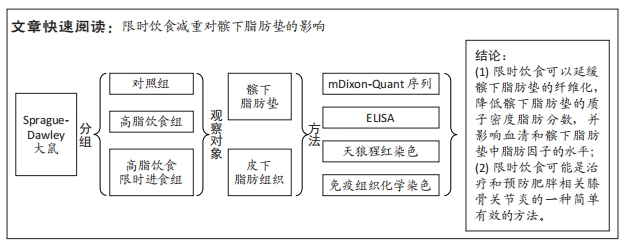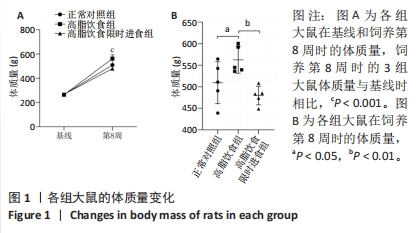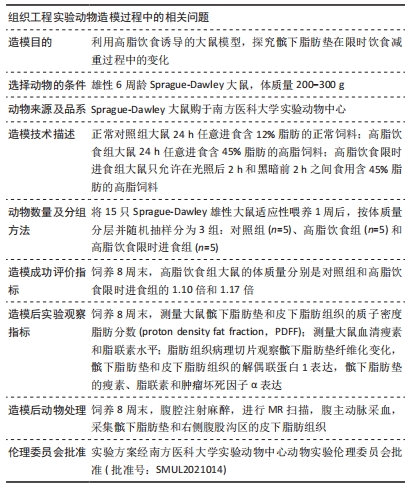[1] ELMALEH-SACHS A, SCHWARTZ JL, BRAMANTE CT, et al. Obesity management in adults: a review. JAMA. 2023;330(20):2000-2015.
[2] BATUSHANSKY A, ZHU S, KOMARAVOLU RK, et al. Fundamentals of OA. An initiative of osteoarthritis and cartilage. Obesity and metabolic factors in OA. Osteoarthritis Cartilage. 2022;30(4):501-515.
[3] COLLINS KH, LENZ KL, POLLITT EN, et al. Adipose tissue is a critical regulator of osteoarthritis. Proc Natl Acad Sci U S A. 2021;118(1): e2021096118.
[4] CHANG J, LIAO Z, LU M, et al. Systemic and local adipose tissue in knee osteoarthritis. Osteoarthritis Cartilage. 2018;26(7):864-871.
[5] ZENG N, YAN ZP, CHEN XY, et al. Infrapatellar fat pad and knee osteoarthritis. Aging Dis. 2020;11(5):1317-1328.
[6] ZHOU S, MALEITZKE T, GEISSLER S, et al. Source and hub of inflammation: the infrapatellar fat pad and its interactions with articular tissues during knee osteoarthritis. J Orthop Res. 2022;40(7):1492-1504.
[7] BARBOZA E, HUDSON J, CHANG WP, et al. Profibrotic infrapatellar fat pad remodeling without m1 macrophage polarization precedes knee osteoarthritis in mice with diet-induced obesity. Arthritis Rheumatol. 2017;69(6):1221-1232.
[8] EYMARD F, PIGENET A, CITADELLE D, et al. Knee and hip intra-articular adipose tissues (IAATs) compared with autologous subcutaneous adipose tissue: a specific phenotype for a central player in osteoarthritis. Ann Rheum Dis. 2017;76(6):1142-1148.
[9] IOAN-FACSINAY A, KLOPPENBURG M. Osteoarthritis: Inflammation and fibrosis in adipose tissue of osteoarthritic joints. Nat Rev Rheumatol. 2017;13(6):325-326.
[10] GIBBS AJ, GRAY B, WALLIS JA, et al. Recommendations for the management of hip and knee osteoarthritis: a systematic review of clinical practice guidelines. Osteoarthritis Cartilage. 2023;31(10):1280-1292.
[11] KATZ JN, ARANT KR, LOESER RF. Diagnosis and treatment of hip and knee osteoarthritis: a review. JAMA. 2021;325(6):568-578.
[12] MESSIER SP, GUTEKUNST DJ, DAVIS C, et al. Weight loss reduces knee-joint loads in overweight and obese older adults with knee osteoarthritis. Arthritis Rheum. 2005;52(7):2026-2032.
[13] HALL M, CASTELEIN B, WITTOEK R, et al. Diet-induced weight loss alone or combined with exercise in overweight or obese people with knee osteoarthritis: a systematic review and meta-analysis. Semin Arthritis Rheum. 2019;48(5):765-777.
[14] JARAMILLO AP, CASTELLS J, IBRAHIMLI S, et al. Time-restricted feeding and intermittent fasting as preventive therapeutics: a systematic review of the literature. Cureus. 2023;15(7):e42300.
[15] LIU D, HUANG Y, HUANG C, et al. Calorie restriction with or without time-restricted eating in weight loss. N Engl J Med. 2022;386(16): 1495-1504.
[16] AOUICHAT S, CHAYAH M, BOUGUERRA-AOUICHAT S, et al. Time-restricted feeding improves body weight gain, lipid profiles, and atherogenic indices in cafeteria-diet-fed rats: role of browning of inguinal white adipose tissue. Nutrients. 2020;12(8):2185.
[17] HATORI M, VOLLMERS C, ZARRINPAR A, et al. Time-restricted feeding without reducing caloric intake prevents metabolic diseases in mice fed a high-fat diet. Cell Metab. 2012;15(6):848-860.
[18] CHAIX A, ZARRINPAR A, MIU P, et al. Time-restricted feeding is a preventative and therapeutic intervention against diverse nutritional challenges. Cell Metab. 2014;20(6):991-1005.
[19] MEHUS AA, RUST B, IDSO JP, et al. Time-restricted feeding mice a high-fat diet induces a unique lipidomic profile. J Nutr Biochem. 2021;88: 108531.
[20] ARBLE DM, BASS J, LAPOSKY AD, et al. Circadian timing of food intake contributes to weight gain. Obesity (Silver Spring). 2009;17(11): 2100-2102.
[21] CHAIX A, MANOOGIAN ENC, MELKANI GC, et al. Time-restricted eating to prevent and manage chronic metabolic diseases. Annu Rev Nutr. 2019;39:291-315.
[22] SUN K, TORDJMAN J, CLEMENT K, et al. Fibrosis and adipose tissue dysfunction. Cell Metab. 2013;18(4):470-477.
[23] DEBARI MK, ABBOTT RD. Adipose tissue fibrosis: mechanisms, models, and importance. Int J Mol Sci. 2020;21(17):6030.
[24] HARASYMOWICZ NS, CLEMENT ND, AZFER A, et al. Regional differences between perisynovial and infrapatellar adipose tissue depots and their response to class II and class III obesity in patients with osteoarthritis. Arthritis Rheumatol. 2017;69(7):1396-1406.
[25] LIU Y, LI Y, LIANG J, et al. The mechanism of leptin on inhibiting fibrosis and promoting browning of white fat by reducing ITGA5 in mice. Int J Mol Sci. 2021;22(22):12353.
[26] DE GOEDE P, HELLINGS TP, COOPMANS TV, et al. After-effects of time-restricted feeding on whole-body metabolism and gene expression in four different peripheral tissues. Obesity (Silver Spring). 2020;28 Suppl 1(Suppl 1):S68-S80.
[27] OUCHI N, PARKER JL, LUGUS JJ, et al. Adipokines in inflammation and metabolic disease. Nat Rev Immunol. 2011;11(2):85-97.
[28] HUI W, LITHERLAND GJ, ELIAS MS, et al. Leptin produced by joint white adipose tissue induces cartilage degradation via upregulation and activation of matrix metalloproteinases. Ann Rheum Dis. 2012; 71(3):455-462.
[29] CHEN TH, CHEN L, HSIEH MS, et al. Evidence for a protective role for adiponectin in osteoarthritis. Biochim Biophys Acta. 2006;1762(8):711-718.
[30] HARIRI N, THIBAULT L. High-fat diet-induced obesity in animal models. Nutr Res Rev. 2010;23(2):270-299.
[31] JUNE RK, LIU-BRYAN R, LONG F, et al. Emerging role of metabolic signaling in synovial joint remodeling and osteoarthritis. J Orthop Res. 2016;34(12):2048-2058.
|








